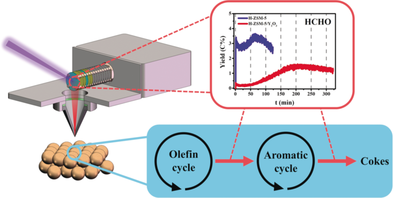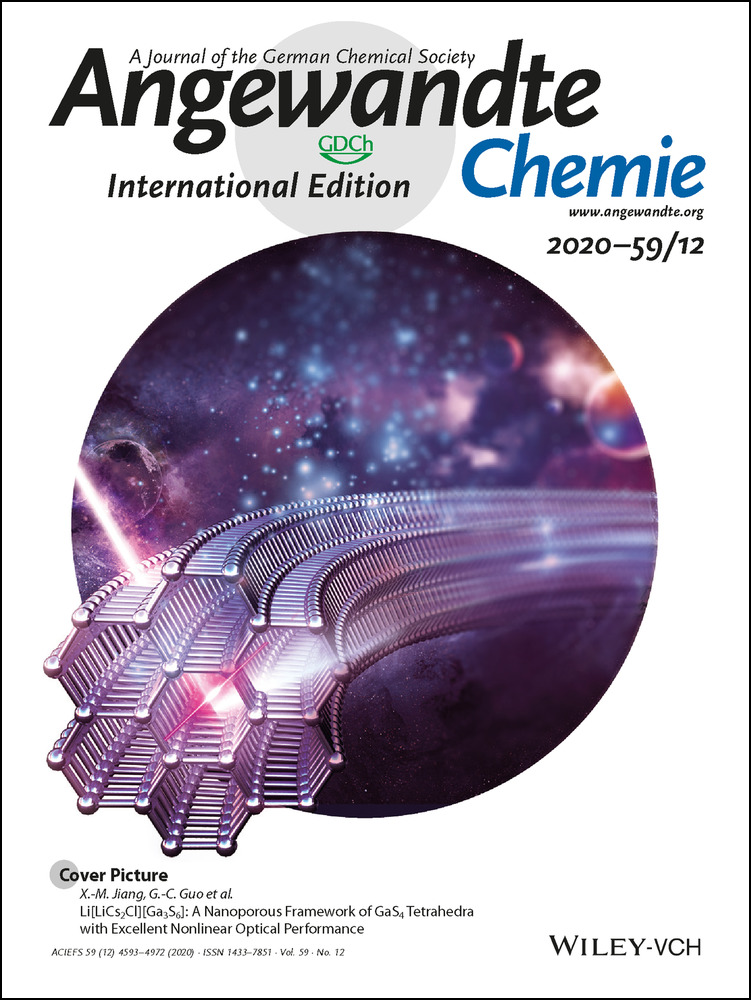Formation and Fate of Formaldehyde in Methanol-to-Hydrocarbon Reaction: In Situ Synchrotron Radiation Photoionization Mass Spectrometry Study
Wu Wen
National Synchrotron Radiation Laboratory, University of Science and Technology of China, Hefei, Anhui, 230029 P. R. China
Search for more papers by this authorShengsheng Yu
National Synchrotron Radiation Laboratory, University of Science and Technology of China, Hefei, Anhui, 230029 P. R. China
Search for more papers by this authorChaoqun Zhou
Key Laboratory for Power Machinery and Engineering of Ministry of Education, Shanghai Jiao Tong University, Shanghai, 200240 P. R. China
Search for more papers by this authorProf. Hao Ma
Key Laboratory for Power Machinery and Engineering of Ministry of Education, Shanghai Jiao Tong University, Shanghai, 200240 P. R. China
Search for more papers by this authorProf. Zhongyue Zhou
Key Laboratory for Power Machinery and Engineering of Ministry of Education, Shanghai Jiao Tong University, Shanghai, 200240 P. R. China
Search for more papers by this authorChuangchuang Cao
Key Laboratory for Power Machinery and Engineering of Ministry of Education, Shanghai Jiao Tong University, Shanghai, 200240 P. R. China
Search for more papers by this authorCorresponding Author
Dr. Jiuzhong Yang
National Synchrotron Radiation Laboratory, University of Science and Technology of China, Hefei, Anhui, 230029 P. R. China
Search for more papers by this authorMinggao Xu
National Synchrotron Radiation Laboratory, University of Science and Technology of China, Hefei, Anhui, 230029 P. R. China
Search for more papers by this authorProf. Fei Qi
Key Laboratory for Power Machinery and Engineering of Ministry of Education, Shanghai Jiao Tong University, Shanghai, 200240 P. R. China
Search for more papers by this authorProf. Guobin Zhang
National Synchrotron Radiation Laboratory, University of Science and Technology of China, Hefei, Anhui, 230029 P. R. China
Search for more papers by this authorCorresponding Author
Prof. Yang Pan
National Synchrotron Radiation Laboratory, University of Science and Technology of China, Hefei, Anhui, 230029 P. R. China
Search for more papers by this authorWu Wen
National Synchrotron Radiation Laboratory, University of Science and Technology of China, Hefei, Anhui, 230029 P. R. China
Search for more papers by this authorShengsheng Yu
National Synchrotron Radiation Laboratory, University of Science and Technology of China, Hefei, Anhui, 230029 P. R. China
Search for more papers by this authorChaoqun Zhou
Key Laboratory for Power Machinery and Engineering of Ministry of Education, Shanghai Jiao Tong University, Shanghai, 200240 P. R. China
Search for more papers by this authorProf. Hao Ma
Key Laboratory for Power Machinery and Engineering of Ministry of Education, Shanghai Jiao Tong University, Shanghai, 200240 P. R. China
Search for more papers by this authorProf. Zhongyue Zhou
Key Laboratory for Power Machinery and Engineering of Ministry of Education, Shanghai Jiao Tong University, Shanghai, 200240 P. R. China
Search for more papers by this authorChuangchuang Cao
Key Laboratory for Power Machinery and Engineering of Ministry of Education, Shanghai Jiao Tong University, Shanghai, 200240 P. R. China
Search for more papers by this authorCorresponding Author
Dr. Jiuzhong Yang
National Synchrotron Radiation Laboratory, University of Science and Technology of China, Hefei, Anhui, 230029 P. R. China
Search for more papers by this authorMinggao Xu
National Synchrotron Radiation Laboratory, University of Science and Technology of China, Hefei, Anhui, 230029 P. R. China
Search for more papers by this authorProf. Fei Qi
Key Laboratory for Power Machinery and Engineering of Ministry of Education, Shanghai Jiao Tong University, Shanghai, 200240 P. R. China
Search for more papers by this authorProf. Guobin Zhang
National Synchrotron Radiation Laboratory, University of Science and Technology of China, Hefei, Anhui, 230029 P. R. China
Search for more papers by this authorCorresponding Author
Prof. Yang Pan
National Synchrotron Radiation Laboratory, University of Science and Technology of China, Hefei, Anhui, 230029 P. R. China
Search for more papers by this authorGraphical Abstract
Formaldehyde (HCHO) was unambiguously detected and quantified for the first time during methanol-to-hydrocarbon catalysis over HSAPO-34 and HZSM-5 by in situ synchrotron radiation photoionization mass spectrometry. The time-resolved profiles of products show that HCHO is mainly derived from the disproportionation of methanol at acidic sites, HCHO affects the hydrogen-transfer processes of olefins into aromatics and aromatics into coke, and HCHO controls the contribution of the aromatic-based cycle.
Abstract
HCHO has been confirmed as an active intermediate in the methanol-to-hydrocarbon (MTH) reaction, and is critical for interpreting the mechanisms of coke formation. Here, HCHO was detected and quantified during the MTH process over HSAPO-34 and HZSM-5 by in situ synchrotron radiation photoionization mass spectrometry. Compared with conventional methods, excellent time-resolved profiles were obtained to study the formation and fate of HCHO, and other products during the induction, steady-state reaction, and deactivation periods. Similar formation trends of HCHO and methane, and their close correlation in yields suggest that they are derived from disproportionation of methanol at acidic sites. In the presence of Y2O3, the amount of HCHO changes, affecting the hydrogen-transfer processes of olefins into aromatics and aromatics into cokes. The yield of HCHO affects the aromatic-based cycle and the formation of ethylene, indicating that ethylene is mainly formed from the aromatic-based cycle.
Supporting Information
As a service to our authors and readers, this journal provides supporting information supplied by the authors. Such materials are peer reviewed and may be re-organized for online delivery, but are not copy-edited or typeset. Technical support issues arising from supporting information (other than missing files) should be addressed to the authors.
| Filename | Description |
|---|---|
| anie201914953-sup-0001-misc_information.pdf1.8 MB | Supplementary |
Please note: The publisher is not responsible for the content or functionality of any supporting information supplied by the authors. Any queries (other than missing content) should be directed to the corresponding author for the article.
References
- 1
- 1aS. Svelle, F. Joensen, J. Nerlov, U. Olsbye, K.-P. Lillerud, S. Kolboe, M. Bjørgen, J. Am. Chem. Soc. 2006, 128, 14770–14771;
- 1bM. Bjørgen, S. Svelle, F. Joensen, J. Nerlov, S. Kolboe, F. Bonino, L. Palumbo, S. Bordiga, U. Olsbye, J. Catal. 2007, 249, 195–207;
- 1cI. Yarulina, A. D. Chowdhury, F. Meirer, B. M. Weckhuysen, J. Gascon, Nat. Catal. 2018, 1, 398.
- 2S. Ilias, R. Khare, A. Malek, A. Bhan, J. Catal. 2013, 303, 135–140.
- 3U. Olsbye, S. Svelle, K. Lillerud, Z. Wei, Y. Chen, J. Li, J. Wang, W. Fan, Chem. Soc. Rev. 2015, 44, 7155–7176.
- 4S. Müller, Y. Liu, F. M. Kirchberger, M. Tonigold, M. Sanchez-Sanchez, J. A. Lercher, J. Am. Chem. Soc. 2016, 138, 15994–16003.
- 5
- 5aS. Ilias, A. Bhan, ACS Catal. 2013, 3, 18–31;
- 5bX. Sun, S. Mueller, H. Shi, G. L. Haller, M. Sanchez-Sanchez, A. C. van Veen, J. A. Lercher, J. Catal. 2014, 314, 21–31.
- 6X. Sun, S. Mueller, Y. Liu, H. Shi, G. L. Haller, M. Sanchez-Sanchez, A. C. van Veen, J. A. Lercher, J. Catal. 2014, 317, 185–197.
- 7
- 7aS. Müller, Y. Liu, M. Vishnuvarthan, X. Sun, A. C. van Veen, G. L. Haller, M. Sanchez-Sanchez, J. A. Lercher, J. Catal. 2015, 325, 48–59;
- 7bJ. S. Martínez-Espín, K. De Wispelaere, T. V. Janssens, S. Svelle, K. P. Lillerud, P. Beato, V. Van Speybroeck, U. Olsbye, ACS Catal. 2017, 7, 5773–5780.
- 8J. S. Martinez-Espin, M. Mortén, T. V. Janssens, S. Svelle, P. Beato, U. Olsbye, Catal. Sci. Technol. 2017, 7, 2700.
- 9J. Dojahn, W. Wentworth, S. Stearns, J. Chromatogr. Sci. 2001, 39, 54–58.
- 10
- 10aC. Wang, Y. Chu, J. Xu, Q. Wang, G. Qi, P. Gao, X. Zhou, F. Deng, Angew. Chem. Int. Ed. 2018, 57, 10197–10201; Angew. Chem. 2018, 130, 10354–10358;
- 10bX. Wu, S. Xu, W. Zhang, J. Huang, J. Li, B. Yu, Y. Wei, Z. Liu, Angew. Chem. Int. Ed. 2017, 56, 9039–9043; Angew. Chem. 2017, 129, 9167–9171.
- 11Y. Liu, F. M. Kirchberger, S. Müller, M. Eder, M. Tonigold, M. Sanchez-Sanchez, J. A. Lercher, Nat. Commun. 2019, 10, 1462.
- 12A. Hwang, A. Bhan, ACS Catal. 2017, 7, 4417–4422.
- 13
- 13aF. Jiao, J. Li, X. Pan, J. Xiao, H. Li, H. Ma, M. Wei, Y. Pan, Z. Zhou, M. Li, S. Miao, J. Li, Y. Zhu, D. Xiao, T. He, J. Yang, F. Qi, Q. Fu, X. Bao, Science 2016, 351, 1065–1068;
- 13bL. Luo, R. You, Y. Liu, J. Yang, Y. Zhu, W. Wen, Y. Pan, F. Qi, W. Huang, ACS Catal. 2019, 9, 2514–2520.
- 14Y. Li, F. Qi, Acc. Chem. Res. 2010, 43, 68–78.
- 15Z. Zhou, X. Du, J. Yang, Y. Wang, C. Li, S. Wei, L. Du, Y. Li, F. Qi, Q. Wang, J. Synchrotron Radiat. 2016, 23, 1035–1045.
- 16
- 16aX. Wu, S. Xu, Y. Wei, W. Zhang, J. Huang, S. Xu, Y. He, S. Lin, T. Sun, Z. Liu, ACS Catal. 2018, 8, 7356–7361;
- 16bS. S. Arora, Z. Shi, A. Bhan, ACS Catal. 2019, 9, 6407–6414.
- 17Y. Liu, S. Müller, D. Berger, J. Jelic, K. Reuter, M. Tonigold, M. Sanchez-Sanchez, J. A. Lercher, Angew. Chem. Int. Ed. 2016, 55, 5723–5726; Angew. Chem. 2016, 128, 5817–5820.
- 18
- 18aJ. Nováková, L. Kubelková, Z. Dolejšek, J. Catal. 1987, 108, 208–213;
- 18bS. R. Blaszkowski, R. A. van Santen, J. Am. Chem. Soc. 1997, 119, 5020–5027.
- 19W. Wang, Y. Jiang, M. Hunger, Catal. Today 2006, 113, 102–114.
- 20
- 20aS. Svelle, M. Visur, U. Olsbye, Saepurahman, M. Bjørgen, Top. Catal. 2011, 54, 897;
- 20bI. M. Hill, S. A. Hashimi, A. Bhan, J. Catal. 2012, 285, 115–123;
- 20cM. N. Mazar, S. Al-Hashimi, A. Bhan, M. Cococcioni, J. Phys. Chem. C 2012, 116, 19385–19395.
- 21
- 21aC.-M. Wang, Y.-D. Wang, Z.-K. Xie, J. Catal. 2013, 301, 8–19;
- 21bC.-M. Wang, Y.-D. Wang, Z.-K. Xie, Catal. Sci. Technol. 2014, 4, 2631–2638.
- 22S. Wang, Y. Chen, Z. Wei, Z. Qin, H. Ma, M. Dong, J. Li, W. Fan, J. Wang, J. Phys. Chem. C 2015, 119, 28482–28498.





